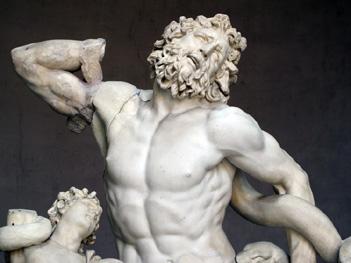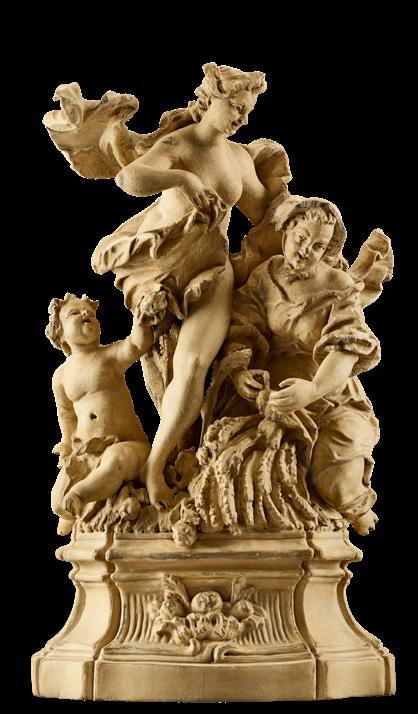
3 minute read
23 Relief of Saint Sebastian, attributed to Christoph Daniel Schenck
from JB Test 01/22
Fig. 2. Laocoön Group, detail, Roman marble copy based on Greek prototype, 1st century BC or AD, Vatican Museums, Rome

Advertisement
Fig. 1. C. D. Schenck, Saint Sebastian, ivory, signed and dated 1675, Württembergisches Landesmuseum, Stuttgart, inv. No. 1954-366
23

Ceres, Allegory of Summer Ferdinand Tietz

25


CERES, ALLEGORY OF SUMMER
FERDINAND TIETZ Holešice, Bohemia 1708-1777 Seehof near Bamberg, Germany
Circa 1760
Height: 30 cm Bozzetto, linden wood with the original polychromy to imitate sandstone
Provenance: Jacques Kugel, circa since the 1960s; By descent.
Related Literature: Brassat, Wolfgang. Ferdinand Tietz, 1708-1777: Symposion und Ausstellung anlässlich des 300. Geburtstags des Rokoko-Bildhauers. Petersberg 2009. Lindemann, Bernd Wolfgang. Ferdinand Tietz 1708-1777,, Weißenhorn 1989, cf. fig. 14 (Allegory of Summer), 109 (Pan), 342 (Mercury). Trenschel, Hans-Peter. Die Bozzetti-Sammlung – Kleinbildwerke des 18. Jahrhunderts im Mainfränkischen Museum Würzburg, Würzburg 1987. Not far from Bamberg is the former summer residence of the prince-bishops, the beautiful palace known as Schloss Seehof. It is an impressive testimony to the once so impressive court upheld by the bishopric and, at the same time, it is the artistic legacy of one of the greatest Rococo artists of southern Germany, Ferdinand Tietz, who originally came from Bohemia.
Born in Holešice in 1708, as Ferdinand Dietz, he later changed the spelling of his surname to ‘Tietz’. He came from a family of craftsmen; his father was a sculptor and had a workshop in Jezeří. Although Ferdinand was later to become a successful sculptor there is no documentary evidence covering the first third of the artist’s lifetime. He most probably went to Vienna where he met the sculptor Johann Wolfgang von der Auwera (1708-1756), as stylistic parallels reveal. It is not until 1736, when he was twentyeight years old, that the artist is mentioned in archival records. He worked under Balthasar Neumann (1687-1753) on large projects in the Würzburg Residenz, as shown on various invoices. In 1747 Tietz was summoned to Bamberg by Prince-Bishop Johann Philipp Anton von Franckenstein (1695-1753) who commissioned him to devise a comprehensive plan of figures for the park at Schloss Seehof. This project represents the highlight of the park’s overall design and Tietz’s artistic breakthrough. Together with his workshop, Tietz – who was appointed court sculptor in 1748 – completed some 400 masterly worked and powerfully modelled sculptures of playfully exuberant figures captured in motion. They were to make the artist famous well beyond the region.
In 1754 Tietz was called to Trier by the prince-bishop Franz Georg von Schönborn (1682-1756) and did not return to Bamberg until 1760 where, in the meantime, Adam Friedrich von Seinsheim (1708–1779), Prince-Bishop of Würzburg, had taken over the prince-bishopric office in Bamberg as well, as the position had become vacant.
25

Front and back side

In 1765 Seinsheim commissioned Tietz to submit new designs for the court garden at Veitshöchheim near Würzburg. To accompany the architectural plans he devised a comprehensive sculptural agenda. The court sculptor made a major contribution to peopling the garden with allegorical stone figures from mythology between 1765 and 1768. Upon completion in 1776, some 300 figures decorated the garden, of which some 200 have survived. They were originally painted a la porcelaine to make them look like China porcelain. That would certainly have made an impressive sight. In 1767 Ferdinand Tietz was also appointed court sculptor in Würzburg. However, after completing his commissions for Würzburg and Bamberg he did not receive any further work of note. His playful style reflecting the zeitgeist of the Rococo period was no longer in keeping with the increasingly sobre and seemingly harsh lines of emerging art tastes. Tietz died in 1777 at the age of 69 in Seehof near Bamberg.
Our figurative group is a so-called bozzetto, a small sculptural work made of lindenwood used as a model that would have been presented to the patron who gave the commission, presumably Adam Friedrich von Seinsheim, before work started on the large sculpture in stone.










